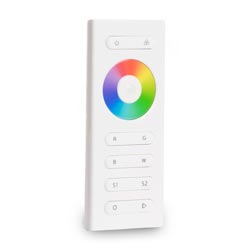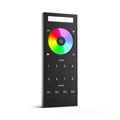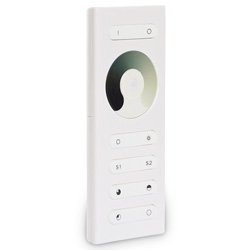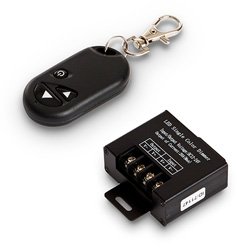To find out more about RF control for LEDs, check out our new blog below.
What is RF?
RF stands for ‘radio frequency’ – referring to the rate of oscillation of an alternating current, which can be used for communication over distances. This measurement represents the oscillation rate a given electromagnetic radiation spectrum. The frequencies range between 300 GHz and can go down to 9kHz.
Why choose RF?
RF LED control is convenient for use as you do not need to be close to the receiving device, so they are suitable in situations such as when having an outdoor event or a Christmas display.
There are also many other diverse uses for RF control in LED lighting, including use in RGB fixtures and lighting for your living room.
RF controllers work up to 20 metres away from the receiver, with no cables required. The receiver can even be hidden behind a wall, whereas infrared (IR) control has to be in the line of site and within a very short distance.
What does RF mean?
This stands for radio frequency and this is converted to infrared in LED lighting controls.
How do you control LED lights using RF?
LED lights are controlled using radio frequency remote controlled RGB LED controllers which are very effective. These type of controls have a radius of up to 20 metres (that’s about 65ft) control for colour changing LEDs.
What is an RF controller?
This is a handled wireless device that operates electronic equipment that uses radio frequency transmission. The advantage of working with an RF controller is that you do not need to aim it at your LED Lighting device for it to work.
What is an RF Receiver?
This is also referred to as a bases station. An RF receiver typically receives radio-frequency communication and converts it to an infrared (IR) signal.
What is the difference between RF and IR?
| RF (radio frequency) | IR (infrared) |
|---|---|
| They can be operated a distance away from the receiving device | You have to be close to the receiving device |
| Signal can go through walls and other objects | Signal is obstructed by walls |
| It is easy to be intercepted | Difficult to be intercepted |
| Does not necessarily need a line of sight | A line of sight is essential |
| It can incur RF interference | It does not incur RF interference |
| A bit expensive | Cheap |
How do you wire an RF LED control system?
RF signal devices work well with a wireless system. They create their own network and transmit and receive messages through radio frequency within an existing wiring system. You do not need to conduct any installation, you only need to plug them to an existing outlet. Once you have done this, you can use the same RF signal devices with additional lighting sources.
Can I control multiple zones using RF?
Yes, you can. At InStyle, we offer an RGB multizone remote control which offers radio control AND wifi control for RGBW LED tape. You can hook this to as many receivers and lighting zones as you need.
This makes it a very good choice for clubs, bars and other places such as restaurants.
Will RF work with home automation systems such as Lutron and KNX?
Yes, it will! Home automation systems typically support the transmission of RF frequencies.
What RF control do Instyle led offer?
At InStyle, we offer remotes and wall controllers for both white (incl. single-colour) and RGBW colour change
Examples include: our RGBW LED controller, which is a complete receiver and controller in one kit to cover for your LED needs, and our RGB multizone remote control, which is an ideal control option for RGB and RGBW LED tapes.
Learn more about these products and others via the following links – and make your order today!!
https://www.instyleled.co.uk/wireless-rgbw-controller-for-led-tape/
https://www.instyleled.co.uk/rgb-multizone-wifi-controller/
Do LED lights using RF interfere with Wifi?
LED lights emit electromagnetic radiation which causes interference within the range of radio and wifi frequencies.
The more the LEDs that you have, the higher the electromagnetic field. So it is important to move your wifi router away from LED lights to avoid RF interference.
You can also find customised insulation materials to protect your wifi (and other communication devices) from electromagnetic fields.
Do LED lights using RF affect radio reception?
Yes, they do!!
LED lights have been reported to affect AM, FM as well as DAB radio reception.
A great way of avoiding interference includes ensuring correct installation, and also buying LED lights that are compliant with the set standards in the market. For more advice, see How can you stop RF interference? below.
How can you stop RF interference?
Radio frequency interference (abbreviated to RFI) will decrease the quality of your signal, and this can cause undesired outcomes. So it’s important to minimise its effects.
If you’re having problems with interference, the hints below may help to reduce or stop RFI:
- You should keep your cables short and also check on your routing. (Unfortunately, a long cable makes for a great antenna!)
- Ensure that the cables you use have heavy gauge shields. A great choice would be to use braided copper shields.
Does RF work through walls?
Definitely! RF works just fine through obstructions such as walls. So you do not need to worry about being up close to the receiving device when using your LED controller.



